It’s a more-than-usually confusing time for the restaurant industry, and above all, for full-service sectors, including casual dining.
Despite changing consumer preferences and macroeconomic headwinds, diners do continue to crave the hospitality value offered only by full-service restaurants. In fact, through September of this year, 42% of adults said they were not using restaurants as often as they would like for on-premises dining, per the National Restaurant Association. While consumers’ appetites for full-service restaurants remain steady, the formula for pleasing today’s sit-down-restaurant consumers is anything but.
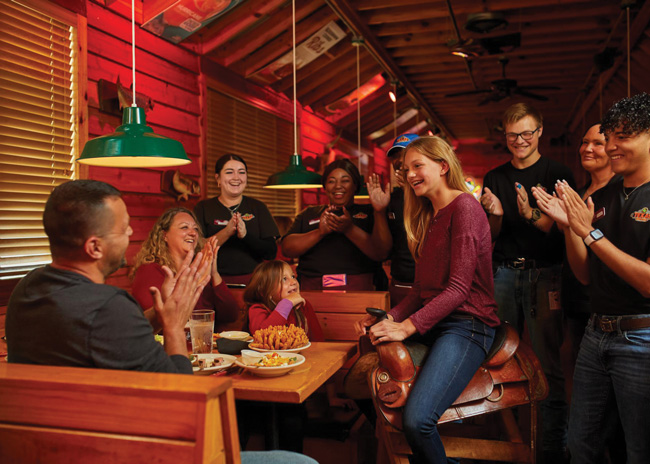 Known for having exceptionally friendly waitstaff, Texas Roadhouse also gets praised for building a sense of community through its restaurants.Case in point: T.G.I. Fridays. The iconic casual dining chain filed for Chapter 11 bankruptcy in November. The chain saw sales decline 15% from 2023 to 2024, per Technomic, and has closed more than 100 restaurants in the past year alone. Among other recent bankruptcies in the casual dining space are Red Lobster and Buca di Beppo.
Known for having exceptionally friendly waitstaff, Texas Roadhouse also gets praised for building a sense of community through its restaurants.Case in point: T.G.I. Fridays. The iconic casual dining chain filed for Chapter 11 bankruptcy in November. The chain saw sales decline 15% from 2023 to 2024, per Technomic, and has closed more than 100 restaurants in the past year alone. Among other recent bankruptcies in the casual dining space are Red Lobster and Buca di Beppo.
But there are success stories as well, and the segment as a whole is up rather than down. Datassential projects modest but hard-won real growth of 0.3% for casual dining in 2025 — demonstrating operators’ “resilience despite inflation and labor challenges,” says Huy Do, research and insights manager at the food and beverage industry tracking firm.
Even though inflation has cooled, casual dining operators still face “immense margin pressures,” Do says. In a Datassential survey, some three-quarters of casual dining restaurant operators said they were struggling with managing labor costs including training and retention, and the same proportion reported challenges in managing food-related decisions such as price-shopping, maximizing ingredient usage and raising menu prices.
Chains Consumers Love
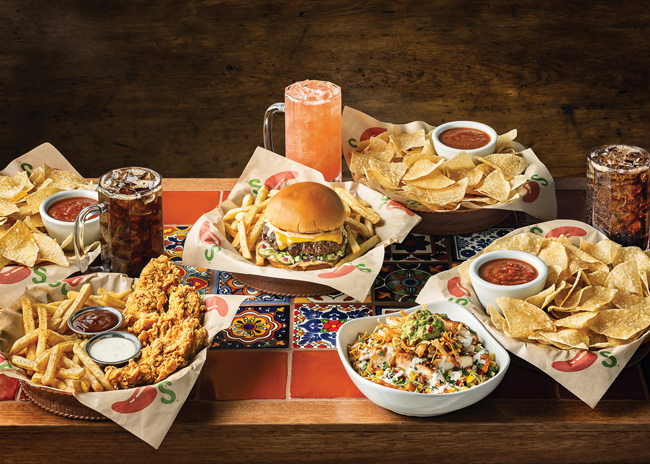 Chili’s Grill & Bar has made a comeback and boosted profitability by focusing on value offerings. Lunch favorites like (left to right) the Crispy Chicken Crispers Combo, the new Big Smasher Burger and the grilled-chicken Santa Fe Salad come with unlimited chips and salsa and a non-alcohol beverage.But examples of thriving chains can be found at high-end polished casual concepts, lower-end family dining spots and price points in between.
Chili’s Grill & Bar has made a comeback and boosted profitability by focusing on value offerings. Lunch favorites like (left to right) the Crispy Chicken Crispers Combo, the new Big Smasher Burger and the grilled-chicken Santa Fe Salad come with unlimited chips and salsa and a non-alcohol beverage.But examples of thriving chains can be found at high-end polished casual concepts, lower-end family dining spots and price points in between.
A number of polls give clues on how consumers see casual dining right now, but surely the most offbeat is one created by consulting firm Menu Matters. “We asked consumers which restaurant they would choose to live in if they had to live in a restaurant for a year,” explains Menu Matters vice president Mike Kostyo. “It was a fun question, but it gets at what consumers think of restaurants, where they choose to spend their time, which restaurants feel like home.”
The winner: Olive Garden, not usually a brand considered particularly innovative. But the consumers who were polled “liked the hospitality,” Kostyo says. Respondents also found the brand’s decor “comfortable and homey.” And then there was the unique value proposition: Olive Garden’s well-known, year-round offer of unlimited salad, soup and breadsticks.
The runners-up were casual dining chains The Cheesecake Factory and Texas Roadhouse. “These are restaurants that consumers want to spend time in, where they value the hospitality, decor and offerings,” Kostyo says.
The Value Equation
The price-value equation offered by casual dining chains chronically gets “squeezed” from above and below, points out Mike Parlapiano, managing director at consulting firm The Culinary Edge.
“There have been a lot of attempts to make it work,” Parlapiano says. “Most recently, Chili’s has made headway after going back to value plays, like its Big Smasher Burger — ‘We’ll give you a product at a price commensurate with fast-casual, but we’ll also give you a full-service restaurant experience with unlimited chips and salsa and a beverage, things a fast-casual player can’t offer.’”
Kostyo also points to Chili’s as a value standout in the casual dining segment. “The new Triple Dipper appetizer that lets customers choose three apps and three sauces to personalize and share now accounts for a whopping 11% of their sales after it went viral on social media — which shows how important marketing is,” he says. “Casual dining, even when the prices are higher than what you may find in a quick-service restaurant, can succeed by focusing on the entire value proposition, not just price.”
But, Parlapiano says, other legacy FSR chains that have tried to differentiate themselves on limited-time offers and value offerings, such as Applebee’s and its Dine Brands stablemate, family dining chain IHOP, have failed to build traffic and sales. (A new test of dual-branded Applebee’s/IHOP stores that share a kitchen and see peak traffic in different dayparts may be another way for Dine Brands to jumpstart growth for both concepts.)
 Loro Asian Smokehouse & Bar is a hybrid concept: It’s similar to a fast-casual restaurant in that patrons order food and drink at the bar and meals are delivered to tables by runners, but the large and stylish units are very much casual dining.
Loro Asian Smokehouse & Bar is a hybrid concept: It’s similar to a fast-casual restaurant in that patrons order food and drink at the bar and meals are delivered to tables by runners, but the large and stylish units are very much casual dining.
Creating a Sense of Community
“Brands like Texas Roadhouse and First Watch do what all great restaurants do,” says Parlapiano. “They double down on hospitality, menu execution and building community.”
Those two chains serve different dayparts (breakfast and lunch at First Watch, dinner for Texas Roadhouse) and they impart their hospitality message in different ways. Texas Roadhouse is known not only for free peanuts and an exceptionally friendly waitstaff, but also for site-specific marketing strategies like locally created murals in its units and sponsorships of community events. First Watch strongly prioritizes its customers’ in-restaurant experience. “They actually throttle their takeout and delivery business during peak mealtimes on Saturdays and Sundays,” Parlapiano says.
Chains that succeed by emphasizing hospitality and community “are sprucing up their facilities, focusing on employee training to build that culture of creating great expectations for the customer, and reinvesting to optimize the dining experience and make it more contemporary,” Parlapiano says. “Those that are lagging behind are lacking in innovation, investment, technology, and training that allows a transient staff to deliver on brand value and the experience proposition.”
Memorable Experiences
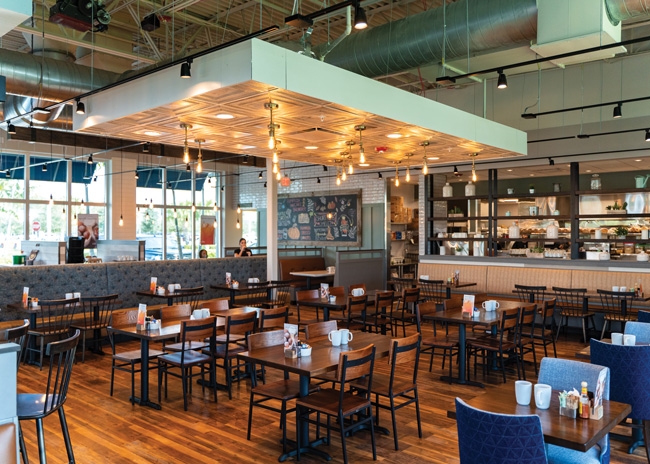 “Casual dining excels when it provides a unique and enjoyable experience, whether through creative dining formats or entertainment,” says Datassential’s Huy Do. “For instance, KPOT combines trending and interactive table-grilled Korean barbecue with hotpot, and Kura Sushi serves their rolls on a conveyor belt. Eatertainment venues like Dave & Buster’s, Topgolf and Pinstripes attract consumers with the promise of both good food and a good time.”
“Casual dining excels when it provides a unique and enjoyable experience, whether through creative dining formats or entertainment,” says Datassential’s Huy Do. “For instance, KPOT combines trending and interactive table-grilled Korean barbecue with hotpot, and Kura Sushi serves their rolls on a conveyor belt. Eatertainment venues like Dave & Buster’s, Topgolf and Pinstripes attract consumers with the promise of both good food and a good time.”
Do also zeroes in on menu differentiation as another key to success. “Chains spotlighting globally influenced flavors saw notable growth in 2023,” he says. “Asian concepts like KPOT, Kura Sushi and Jinya Ramen Bar, as well as Mexican-inspired brands like Torchy’s Tacos, Plaza Azteca and El Torito Cantina Autentico, reported double-digit growth in location count and systemwide sales.” But tried-and-true steak and seafood concepts can also differentiate on menus, he adds: “Concepts that offer craveable, luxurious menu offerings without hitting fine-dining price points have seen solid success: Texas Roadhouse, Longhorn Steakhouse and seafood boil concepts The Juicy Crab and Crafty Crab grew systemwide sales by over 10% last year.”
Pared-Down Focus
“Operators are slimming down the menu more, opting for dishes that are easier to execute, and looking for supply solutions like more speed-scratch products,” says Kostyo of Menu Matters. “It’s not just that they don’t have the labor, which is true, but that the labor they do have doesn’t always have culinary experience.”
Parlapiano cites several casual dining chains that have taken the simplified-menu route. “They’re offering full service but are much more focused on a limited menu of small plates and a cantina style of operation that strips away the formality of knife-and-fork entrees,” he explains. “They facilitate community gathering and can drive incredible check averages.” Some, he says, are “hybrid concepts in which guests order at the counter and get their meals delivered to their table by runners — but they’re large-format, big-box restaurants with a bar and a drinking component. These places operate like an engine and don’t require a ton of human bodies to run.”
For instance, Texas-based Loro Asian Smokehouse & Bar uses its website to instruct customers: “We keep it casual and communal. Sharing is encouraged. Order food at the bar and sit in our thoughtfully designed indoor space or hang outside on the expansive patio and beer garden. Bring your friends, your family, and your pups. Just come as you are, kick back, and stay awhile.”
Parlapiano also points to Miami-based Tacology as an example of this genre. “Their menu is split 50-50 between food and drink,” he says. “The focus is on small plates like guacamole, chips, elotes, queso fundido and tacos — foods that, for all intents and purposes, can be produced out of a kitchen the size of a food truck.” And that’s how the brand’s dining rooms are styled: The expo kitchen and serving window have the look of a food truck or kiosk.
A third example: Ohio-headquartered Condado Tacos. “It’s a similar model, with drinking occasions front and center, easy-to-execute cocktails like margaritas and mezcal drinks, and an easy-to-execute menu of tacos,” Parlapiano explains. “Customers feel that they’re getting something unique, check averages are high because of the beverage component, but from an operational standpoint, the concept is easy to execute.”
Beverages
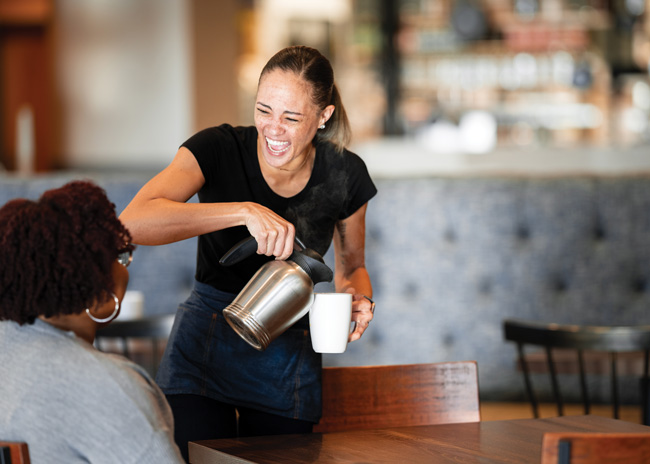 Breakfast, brunch and lunch chain First Watch operates more than 540 restaurants in 29 states.“Casual dining remains a popular setting for indulgence, and alcohol plays a key role,” says Do. “Alcoholic beverages account for a quarter of the typical revenue mix.” In fact, he adds, 59% of casual dining operators say they’ve seen increased sales of spirits, 30% report higher beer sales and 26% report higher wine sales.
Breakfast, brunch and lunch chain First Watch operates more than 540 restaurants in 29 states.“Casual dining remains a popular setting for indulgence, and alcohol plays a key role,” says Do. “Alcoholic beverages account for a quarter of the typical revenue mix.” In fact, he adds, 59% of casual dining operators say they’ve seen increased sales of spirits, 30% report higher beer sales and 26% report higher wine sales.
But alcohol isn’t the only potential revenue driver among liquids offered in casual dining, Kostyo points out. “Beverages, particularly on the non-alcohol side, continue to be an innovation center, especially for younger consumers,” he says. “Everything from energy drinks to boba teas to dirty sodas have been trending in recent years. Casual dining operators can create unique, experiential beverages for a range of dayparts that resonate with consumers and increase check averages.”
One example of a casual dining chain putting beverages front and center is Illinois-based Cooper’s Hawk, an upscale concept that’s deeply rooted in wine culture,” says Parlapiano. “It has continued to grow by delivering an approachable yet elevated dining experience, with a compelling experiential package for guests seeking something unique and worth splurging on. Unlike concepts that seek to save on labor or streamline prep, Cooper’s Hawk invests significantly in both, creating a distinct, high-quality experience that sets them apart from traditional casual dining brands.”
Takeout
“Casual dining operators are still able to supplement their typical earning channels with additional revenue from off-premises offerings: curbside, delivery, family meals, and off-premises alcohol sales,” says Datassential’s Do. Revenue from sales for off-premises consumption accounts for roughly 30% of casual dining operators’ typical sales mix, he says, but “we believe that share of revenue has peaked and will likely continue to fall in 2025. While effective for some casual dining operators, off-premises sales are unlikely to match the revenue impact they provide for limited-service restaurants.”
Do advises that casual dining’s route to success in takeout is to focus on “craveable menu items designed to work well both on-premises and off.” Craveability is a big consideration for takeout customers, he says, with a craving for a specific item cited by nearly two-thirds of consumers who recently ordered casual dining delivery. Just as important, he adds, is for operators to ensure that the off-premises ordering experience they offer is simple and efficient, considering that almost 90% of repeat delivery customers cite a positive experience with an earlier order as motivation to order from the same restaurant again.
Casual dining concepts are a mixed bag on takeout, Parlapiano says. “Certain brands are embracing it; others are not,” he says. “If you offer an amazing guest experience within your four walls, that’s where your value proposition lies. But chains like Applebee’s and Chili’s have settled on a formula of off-premises accounting for about 20% of food sales.” Takeout can be tricky, he points out: “Operators seek to offer a great experience for dine-in customers, while also ensuring off-premises customers’ needs are taken care of and prioritized.” Chains that are determined to succeed in both channels, he says, are investing in technology and infrastructure, from upgrading POS systems to reorganizing dining rooms and parking lots: “They want to keep each sales channel healthy to capture all the revenue they possibly can.”
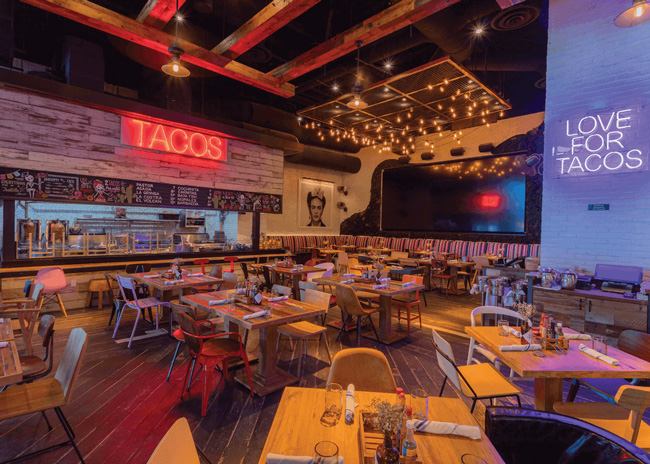 Tacology is an easy-to-operate format popular with today’s diners who seek informal, convivial settings. The menu emphasizes drinks and Mexican snacks, and the servery is designed to evoke a food truck or kiosk.
Tacology is an easy-to-operate format popular with today’s diners who seek informal, convivial settings. The menu emphasizes drinks and Mexican snacks, and the servery is designed to evoke a food truck or kiosk.
Technology Solutions
More than a quarter of casual dining operators are planning to make capital improvements in the coming year, while 38% “might consider” doing so, reports Do. Among those scheduling improvements, 57% intend to upgrade food prep equipment, 27% have plans for better back-of-house technology, and 25% are boosting customer-facing front-of-house technology.
“Casual dining operators are open to utilizing new technology for a variety of applications, from saving labor and improving back-of-house efficiencies, to enhancing customer experiences and building loyalty,” Do says. As of today, he says, a third of operators allow patrons to pay via their websites, and a third have tablets for servers. Digital marketing tactics prevail over old-fashioned signage, coupons and radio and TV ads.
Operators are also exploring artificial intelligence, Do says. In an October 2024 survey, more than 90% of casual dining operators reported having experienced or engaged with AI technology within the past year. He says operators are interested in AI to help them with marketing and promotion, collecting and analyzing customer feedback, research and inspiration, and logistical tasks like purchasing management or nutrition analysis, but few seek AI assistance with food prep, cooking or customer service. “Going forward, casual dining operators will likely be interested in leveraging AI tools to automate mundane or administrative tasks to save time, money, and labor, making human employees’ lives easier instead of wholly replacing them,” he says—but only if AI-powered solutions become more accessible, reputable, trustworthy and affordable.
Greater reliance on technology is the future of foodservice, but finding the right tech can be tricky, says Kostyo. “Casual dining operators need to balance the use of technology with the hospitality and human touch that differentiate the segment,” he cautions. “If a customer is coming into a casual dining restaurant and ordering from a ton of screens and it feels very transactional, you haven’t differentiated yourself from a quick-service experience.” His advice: “The top things that consumers want from tech in foodservice are lower prices and more customization — so feature those benefits in the tech solutions you adopt.”




